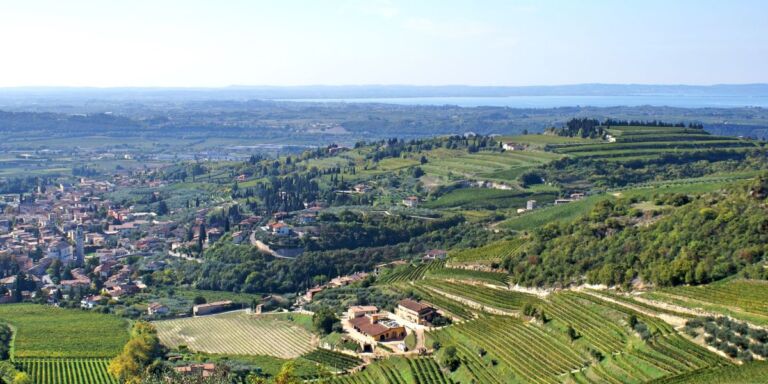Since the Phillips family decided to make their own wine from this celebrated Oakville terroir, Vine Hill Ranch has become one of the most sought-after labels in Napa. The history of this remarkable estate goes back to the gold rush, while its reputation as a vineyard of exceptional quality starts in the 1950s: from André Tchelistcheff to Nigel Kinsman, Vine Hill Ranch has been attracting the most ambitious Napa winemakers for generations. But it’s only recently that the name gained renown among serious collectors. Arguably, you can date Vine Hill Ranch’s modern incarnation to the early 2000s, when Robert Phillips, the father of current owner Bruce Phillips, wondered aloud what it would be like to make his own wine.
The origins of Vine Hill Ranch
Grapes have been grown at Vine Hill Ranch for around 150 years, along with oranges, peaches, pears, apples, quinces and walnuts. Bruce Phillips has a fine collection of 19th-century tax documents that he likes to show visitors: one yellowed piece of paper from 1885 notes that 120 tons of grapes were ‘sold for market’ that year. You have to fast-forward to 1956, when Bruce Kelham, grandson of a gold rush pioneer, bought the ranch, to find its origins as a vineyard of note.
Kelham quickly established a reputation, selling his entire production to Beaulieu Vineyard and its winemaker André Tchelistcheff, much of it going into the flagship Georges de Latour. That relationship lasted from 1957 to 1974. And from it followed others: Robert Mondavi began taking fruit for his Reserve blend, in 1981 Dan Duckhorn started buying Merlot for his Vine Hill Ranch cuvée (an early example of a vineyard-designate Napa wine), Jack Cakebread had a contract, as did Araujo, Etude, Robin Lail. Then Bill Harlan took on Vine Hill Ranch fruit for Vecina, part of his BOND project, which aimed to showcase individual terroirs. Robert Parker took notice. ‘That was kind of seminal’, Phillips says.

Among the important people in the Vine Hill Ranch story are Phillips’ parents, Robert (Bob) and Alex. ‘In 1986 my father began digging holes to understand the architecture of the vineyard,’ he remembers. Bob and Bruce divided the vineyard into 12 blocks, each one with a different clone and rootstock, canopy configuration and row direction. The decision was also made to concentrate on Cabernet Sauvignon. This was a huge risk to take at a time when Napa Chardonnay was selling for many times the price of Cabernet. ‘It wasn’t an economic decision but a quality decision,’ Phillips says.
The fact that so many respected winemakers and critics were taking an interest in Vine Hill Ranch ‘validated for us our strategy of vineyard designation and really began to drive attention to what we could do here.’ Bob Phillips was a visionary in that he saw the future for Cabernet in Napa. And he was also a pioneer of vineyard-designate wines, which in the 1980s were scarce. ‘The idea of building equity in your vineyard name, through the wines produced by your vintner partners, was an interesting one.’

The goal, then as now, was complexity, and adherence to the concept of the primacy of site. The community of winemakers that is the bedrock of Vine Hill Ranch at present consists of: the Araujo family’s Accendo Cellars; Arrow & Branch; BOND; Colgin; DVO (Maya Dalla Valle’s project with Axel Heinz of Ornellaia); Etude; Lail Vineyards; Keplinger; two projects with Nigel Kinsman of Kinsman Eades; Memento Mori; Tor Kenward and a new project with celebrated winemaker Maayan Koschitsky for Simon Family. Each of these, Phillips says, ‘honours the vineyard stylistically.’ They are ambassadors for Vine Hill Ranch.
The decision was made to concentrate on Cabernet – a huge risk when Napa Chardonnay was selling for many times the price
It was in the early 2000s that Bob Phillips decided to turn from grower to winemaker. ‘My father said, ‘I wonder how it would be if we made wine?’’ Part of the impetus was that in 2004 Napa wines were – as Phillips puts it – ‘behemoths. ‘And as growers, we were not happy about the direction that it was taking. And so we wanted to create wines of balance that were uniquely reflective of the growing season, and really showcase what the site can deliver, and how we farm it.’
What goes into making Vine Hill Ranch?
The ranch is 600 acres (243 hectares) in total, of which 70 acres (28ha) are planted with vines. Everything in the seven ‘master blocks’ that make up the vineyard is predicated on the subtle differences in terroir. So the deep, loamy soils of the lower-lying blocks will produce ‘bright fruit flavours and fine tannins’ while the sloping, gravelly soils higher up produce concentrated fruit with intense tannins.
The family takes grapes from 18 different parcels within these blocks. Phillips stresses that these aren’t necessarily the best or ‘strongest’ grapes, but ‘the aspects of those particular areas of the vineyard that don’t occur anywhere else in the vineyard. So rather than just picking the strongest portions of every block, the effort here was really to drive complexity to our blend.’

Vinification is light-touch (there’s no ‘New World fancy winemaking’ as Phillips puts it): stringent sorting of the fruit, cold-soaking, extended maceration, and spontaneous fermentation with native yeast. The parcels are vinified separately. In keeping with the mantra of the primacy of the site, winemaker Françoise Peschon (just closing her 16th vintage) and vineyard manager Michael Wolf (some 30 vintages) make few changes in the vinification season by season.
‘It has more to do with an understanding of what each portion of this vineyard is going to deliver,’ Phillips notes. The fact that the wines from later vintages are so much more complex ‘speaks to Peschon’s understanding of the interplay of the various source blocks.’ Volume goes up and down depending on the year. Normally it’s 1,200 cases but in a lower-yielding year, like 2020, the production is half that.

How did the design come about?
During a lunch in 2004, when they were planning how to source and make their wine, ‘we realised what a wonderful opportunity we had to educate people about the nature of this site, how we farm it, the notion of vintage variability.’ The label (inspired by those old tax documents) is designed ‘to lend transparency to each vintage in terms of understanding what blocks are in the blend, the relative planting densities of those blocks, the harvest dates and the yields.’
What’s next for Vine Hill Ranch?
Phillips’ ambition is simple: ‘If Vine Hill Ranch is established among the great vineyards of the world, I will have succeeded.’ He’s well on the way. VHR Cabernet Sauvignon commands a price some three-and-a-half times the average for Napa Cabernet; the vineyard, long-loved by professionals, is now cementing its reputation among collectors.
If Vine Hill Ranch is established among the great vineyards of the world, I will have succeeded
Vine Hill Ranch is currently vinified at Arkenstone on Howell Mountain; however, Phillips has no plans to build a winery. While pioneers like Mondavi saw the need to attract visitors with a dramatic new building, ‘I don’t know necessarily if the path forward is to continue to build these iconic structures.’ He makes the valid point that Napa is full of top-class winemaking facilities, and for him, the future is ‘rather the stewardship of singular vineyard land. And that’s a bit of a paradigm shift.’
As for succession, Phillips and his wife Heather are the operating members of the family; they have two children, numerous nephews and nieces (some of whom are forging careers in wine); he has two sisters. ‘All are very vested in the vineyard, and in its heart,’ Phillips says. The next generation will be the fourth at Vine Hill Ranch. ‘And that’s my vision: to carry it forward and onwards. It’s all about the love of this place.’








